- Home
- Dean Koontz
Night Chills Page 3
Night Chills Read online
Page 3
recall that data at will. Three, subliminal perception is nothing strange or occult; it is an integral part of our lives.”
“Perhaps the major part of our lives.”
“And you’ve discovered a commercial use of subliminal perception. ”
Salsbury’s hands were shaking. He was close to the core of his proposition, and he didn’t know whether Dawson would be fascinated or outraged by it. “For two decades, advertisers of consumer products have been able to reach the subconscious minds of potential customers by the use of subliminal perception. The ad agencies refer to these techniques by several other names. Subliminal reception. Threshold regulation. Unconscious perception. Subception. Are you aware of this? Have you heard of it?”
Still enviably relaxed, Dawson said, “There were several experiments conducted in movie theaters—fifteen—maybe twenty years ago. I remember reading about them in the newspapers. ”
Salsbury nodded rapidly. “Yes. The first was in 1957.”
“During an ordinary showing of some film, a special message was superimposed on the screen. ‘You are thirsty,’ or something of that sort. It was flashed off and on so fast that no one realized it was there. After it had been flashed—what, a thousand times?—nearly everyone in the theater went to the lobby and bought soft drinks.”
In those first crude experiments, which were carefully regulated by motivation researchers, subliminal messages had been delivered to the audience with a tachistoscope, a machine patented by a New Orleans company, Precon Process and Equipment Corporation, in October of 1962. The tachistoscope was a standard film projector with a high-speed shutter. It could flash a message twelve times a minute at 1/3000 of a second. The image appeared on the screen for too short a time to be perceived by the conscious mind. But the subconscious was fully aware of it. During a six-week test of the tachistoscope, forty-five thousand theater-goers were subjected to two messages: “Drink Coca-Cola” and “Hungry? Eat Popcorn.” The results of these experiments left no doubt about the effectiveness of subliminal advertisement. Popcorn sales rose sixty percent, and Coca-Cola sales rose nearly twenty percent.
The subliminals apparently had influenced people to buy these products even though they were not hungry or thirsty.
“You see,” Salsbury said, “the subconscious mind believes everything it is told. Even though it constructs behavioral sets based on the information it receives, and although those sets guide the conscious mind—it can’t distinguish between truth and falsehood! The behavior that it programs into the conscious mind is often based on misconceptions. ”
“But if that were correct, we’d all behave irrationally.”
“And we all do,” Salsbury said, “in one way or another. Don’t forget, the subconscious doesn’t always construct programs based on wrong-headed ideas. Just sometimes. This explains why intelligent men, paragons of reason in most things, harbor at least a few irrational attitudes. ” Like your religious fanaticism, he thought. He said: “Racial and religious bigotry, for instance. Xenophobia, claustrophobia, acrophobia ... If a man can be made to analyze one of these fears on a conscious level, he’ll reject it. But the conscious resists analysis. Meanwhile, the inner half of the mind continues to misguide the outer half.”
“These messages on the movie screen—the conscious mind wasn’t aware of them; therefore, it couldn’t reject them.”
Salsbury sighed. “Yes. That’s the essence of it. The subconscious saw the messages and caused the outer mind to act on them.”
Dawson was growing more interested by the minute. “But why did the subliminals sell more popcorn than soda?”
“The first message—‘Drink Coca-Cola’—was a declarative sentence,” Salsbury said, “a direct order. Sometimes the subconscious obeys an order that’s delivered subliminally—and sometimes it doesn’t. ”
“Why is that?”
Salsbury shrugged. “We don’t know. But you see, the second subliminal was not entirely a direct order. It was more sophisticated. It began with a question: ‘Hungry?’ The question was designed to cause anxiety in the subconscious. It helped to generate a need. It established a ‘motivational equation.’ The need, the anxiety, is on the left side of the equals sign. To fill the right side, to balance the equation, the subconscious programs the conscious to buy the popcorn. One side cancels out the other. The buying of the popcorn cancels out the anxiety. ”
“The method is similar to posthypnotic suggestion. But I’ve heard that a man can’t be hypnotized and made to do something he finds morally unacceptable. In other words, if he isn’t a killer by nature, he can’t be made to kill while under hypnosis.”
“That’s not true,” Salsbury said. “Anyone can be made to do anything under hypnosis. The inner mind can be manipulated so easily ... For example, if I hypnotized you and told you to kill your wife, you wouldn’t obey me.”
“Of course I wouldn’t!” Dawson said indignantly.
“You love your wife.”
“I certainly do!”
“You have no reason to kill her.”
“None whatsoever.”
Judging by Dawson’s emphatic denials, Salsbury thought the man’s subconscious must be brimming with repressed hostility toward his God-fearing, church-loving wife. He didn’t dare say as much. Dawson would have denied it—and might have tossed him out of the office. “However, if I hypnotized you and told you that your wife was having an affair with your best friend and that she was plotting to kill you in order to inherit your estate, you would believe me and—”
“I would not. Julia would be incapable of such a thing.”
Salsbury nodded patiently. “Your conscious mind would reject my story. It can reason. But after I’d hypnotized you, I’d be speaking to your subconscious—which can’t distinguish between lies and truth.”
“Ah. I see.”
“Your subconscious won’t act on a direct order to kill because a direct order doesn’t establish a motivational equation. But it will believe my warning that she intends to kill you. And so believing, it will construct a new behavioral set based on the lies—and it will program your conscious mind for murder. Picture the equation, Leonard. On the left of the equals sign there is anxiety generated by the ‘knowledge’ that your wife intends to do away with you. On the right side, to balance the equation, to banish the anxiety, you need the death of your wife. If your subconscious was convinced that she was going to kill you in your sleep tonight, it would cause you to murder her before you ever went to bed.”
“Why wouldn’t I just go to the police?”
Smiling, more sure of himself than he had been when he entered the office, Salsbury said, “The hypnotist could guard against that by telling your subconscious that your wife would make it look like an accident, that she was so clever the police would never prove anything against her.”
Raising one hand, Dawson waved at the air as if he were shooing away flies. “This is all very interesting,” he said in a slightly bored tone of voice. “But it seems academic to me.”
Ogden’s self-confidence was fragile. He began to tremble again. “Academic?”
“Subliminal advertising has been outlawed. There was quite a to-do at the time.”
“Oh, yes,” Salsbury said, relieved. “There were hundreds of newspaper and magazine editorials. Newsday called it the most alarming invention since the atomic bomb. The Saturday Review said that the subconscious mind was the most delicate apparatus in the universe and that it must never be sullied or twisted to boost the sales of popcorn or anything else.
“In the late 1950s, when the experiments with the tachistoscope were publicized, nearly everyone agreed that subliminal advertising was an invasion of privacy. Congressman James Wright of Texas sponsored a bill to outlaw any device, film, photograph, or recording ‘designed to advertise a product or indoctrinate the public by means of making an impression on the subconscious mind.’ Other congressmen and senators drafted legislation to deal with the menace, but none
of the bills got out of committee. No law was passed restricting or forbidding subliminal advertising.”
Dawson raised his eyebrows. “Do politicians use it?”
“Most of them don’t understand the potential. And the advertising agencies would just as soon keep them ignorant. Every major agency in the U.S. has a staff of media and behavioral scientists to develop subliminals for magazine and television ads. Virtually every consumer item produced by Futurex and its subsidiaries is sold with subliminal advertising.”
“I don’t believe it,” Dawson said. “I would know about it. ”
“Not unless you wanted to know and made an effort to learn. Thirty years ago, when you were starting out, this sort of thing didn’t exist. By the time it came into use, you were no longer closely tied to the sales end of your business. You were more concerned with stock issues, mergers—wheeling and dealing. In a conglomerate of this size, the president can’t possibly pass approval on every ad for every product of every subsidiary.”
Leaning forward in his chair, a look of distaste on his handsome face, Dawson said, “But I find it rather—repulsive.”
“If you accept the fact that a man’s mind can be programmed without his knowledge, you’re rejecting the notion that every man is at all times captain of his fate. It scares hell out of people.
“For two decades Americans have refused to face the unpleasant truth about subliminal advertising. Opinion polls indicate that, of those who have heard of subliminal advertising, ninety percent are certain it has been outlawed. They have no facts to support this opinion, but they don’t want to believe anything else. Furthermore, between fifty and seventy percent of those polled say they don’t believe subliminals work. They are so revolted by the thought of being controlled and manipulated that they reject the possibility out of hand. Rather than educate themselves about the actuality of subliminal advertising, rather than rise up and rage against it, they dismiss it as a fantasy, as science fiction. ”
Dawson shifted uneasily in his chair. Finally, he got up, went to the huge windows and stared out at Manhattan.
Snow had begun to fall. There was very little light in the sky. Wind, like the voice of the city, moaned on the far side of the glass.
Turning back to Salsbury, Dawson said, “One of our subsidiaries is an ad agency. Woolring and Messner. You mean every time they make a television commercial, they build into it a series of subliminally flashed messages with a tachistoscope?”
“The advertiser has to request subliminals,” Salsbury said. “The service costs extra. But to answer your question—no, the tachistoscope is out of date.
“The science of subliminal behavior modification developed so rapidly that the tachistoscope was obsolete soon after it was patented. By the mid-1960s, most subliminals in television commercials were implanted with rheostatic photography. Everyone has seen a rheostatic control for a lamp or overhead light: by turning it, one can make the light dimmer or brighter. The same principle can be used in motion picture photography. First, the commercial is shot and edited to sixty seconds in the conventional manner. This is the half of the advertisement that registers with the conscious mind. Another minute of film, containing the subliminal message, is shot with minimal light intensity, with the rheostat turned all the way down. The resultant image is too dim to register with the conscious mind. When it is projected on a screen, the screen appears to be blank. However, the subconscious sees and absorbs it. These two films are projected simultaneously and printed on a third length of film. It is this composite version that is used on television. While the audience watches the commercial, the subconscious mind watches—and obeys, to one degree or another—the subliminal directive.
“And that’s only the basic technique,” Salsbury said. “The refinements are even more clever.”
Dawson paced. He wasn’t nervous. He was just—excited.
He’s beginning to see the value, Salsbury thought happily.
“I see how subliminals could be hidden in a piece of film that’s full of motion, light and shadow,” Dawson said. “But magazine ads? That’s a static medium. One image, no movement. How could a subliminal be concealed on one page?”
Pointing to the photographs he had given Dawson earlier, Salsbury said, “For that picture I kept my face expressionless. Two copies were made from the same negative. Copy A was printed over a vague image of the word ‘anger.’ And B was printed over the word ‘joy. ’”
Comparing the photos, Dawson said, “I don’t see either word.”
“I’d be displeased if you did. They aren’t meant to be seen.”
“What was the purpose?”
“One hundred students at Columbia were given photo A and asked to identify the emotion expressed by the face. Ten students had no opinion. Eight said ‘displeasure’ and eighty-two said ‘anger.’ A different group studied photo B. Eight expressed no opinion. Twenty-one said ‘happiness’ and seventy-one said ‘joy.”’
“I see,” Dawson said thoughtfully.
Salsbury said, “But that’s as crude as the tachistoscope. Let me show you some sophisticated subliminal ads.” He plucked a sheet of paper from his briefcase. It was a page from Time magazine. He put the page on Dawson’s blotter.
“It’s an ad for Gilbey’s Gin,” Dawson said.
At a glance it was a simple liquor advertisement. A five-word headline stood at the top of the page: BREAK OUT THE FROSTY BOTTLE. The only other copy was toward the lower right-hand comer: AND KEEP YOUR TONICS DRY! The accompanying illustration held three items. The most prominent of these was a bottle of gin which glistened with water droplets and frost. The cap of the bottle lay at the bottom of the page. Beside the bottle was a tall glass filled with ice cubes, a lime slice, a swizzle stick and, presumably, gin. The background was green, cool, pleasant.
The message intended for the conscious mind was clear: This gin is refreshing and offers an escape from everyday cares.
What the page had to say to the subconscious mind was far more interesting. Salsbury explained that most of the subliminal content was buried beneath the threshold of conscious recognition, but that some of it could be seen and analyzed, although only with an open mind and perseverance. The subliminal that the conscious could most easily comprehend was hidden in the ice cubes. There were four ice cubes stacked one atop the other. The second cube from the top and the lime slice formed a vague letter S which the conscious mind could see when prompted. The third cube held a very evident letter E in the area of light and shadow that comprised the cube itself. The fourth chunk of ice contained the subtle but unmistakable outline of the letter X: S-E-X.
Salsbury had come around behind Dawson’s desk and had carefully traced these three letters with his forefinger. “Do you see it?”
Scowling, Dawson said, “I saw the E immediately and the other two without much trouble. But I’m finding it hard to believe they were put there on purpose. It could be an accident of shading:”
“Ice cubes usually don’t photograph well,” Salsbury said. “When you see them in an advertisement, they’ve nearly always been drawn by an artist. In fact, this entire ad has been painted over a photograph. But there’s more than the word in the ice.”
Squinting at the page, Dawson said, “What else?”
“The bottle and glass are on a reflective surface.” Salsbury circled that area of the reflection that dealt with the bottle and the cap. “Without stretching your imagination too far, can you see that the reflection of the bottle is divided in two, forming what might be taken to be a pair of legs? Do you see, also, that the reflected bottle cap resembles a penis thrusting out from between those legs?”
Dawson bristled. “I can see it,” he said coldly.
Too interested in his own lecture to notice Dawson’s uneasiness, Salsbury said, “Of course, the melting ice on the bottle cap could be semen. That image was never meant to be entirely subliminal. The conscious mind might recognize the intent here. But it would not recognize the reflection in
that table unless it was guided to the recognition.” He pointed to another spot on the page. “Would it be going too far to say these shadows between the reflections of the bottle and the glass form vaginal lips? And that this drop of water on the table is positioned on the shadows precisely where the clitoris would be on a vagina?”
When he perceived the subliminal sex organ, its lips parted, Dawson blushed. “I see it. Or I think I do.”
Salsbury reached in his briefcase. “I’ve got other examples.”
One of them was a two-page subscription solicitation that had appeared shortly before Christmas several years before, in Playboy. On the right-hand page, Playmate Liv Lindeland, a busty blonde, knelt on a white carpet. On the lefthand page stood an enormous walnut wreath. She was tying a red bow to the top of the wreath.
In one test, Salsbury explained, a hundred subjects spent an hour studying two hundred advertisements, including this one. When the hour ended they were asked to list the first ten of those items that they could remember. Eighty-five percent listed the Playboy ad. In describing it, all but two subjects mentioned the wreath. Only five of them mentioned the girl. When questioned further, they had trouble recalling if she was a blonde, brunette, or redhead. They remembered that her breasts were uncovered, but they couldn’t say for sure whether she was wearing a hat or was clothed from the waist down. (She had no hat and was nude.) None of them had trouble describing the wreath, for it was there that the subconscious had been riveted.
“Do you see why?” Salsbury asked. “There’s not a walnut in that ‘walnut’ wreath. It’s composed of objects that resemble the heads of penises and vaginal slits.”
Unable to speak, Dawson leafed through the other advertisements without asking Salsbury to explain them. Finally he said, “Camel cigarettes, Seagram’s, Sprite, Bacardi Rum ... Some of the most prominent companies in the country are using subliminals to sell their products.”
“Why shouldn’t they? It’s legal. If the competition uses them, what choice does even the most morally uplifted company really have? Everyone has to stay competitive. In short, there are no individual villains. The whole system is the villain.”
Dawson returned to his executive chair, his face a book of his thoughts. One could read there that he disliked any talk against “the system” and that he was nonetheless shocked by what he had been shown. He was also trying to see how he could make a profit from it. He operated with the conviction that God wanted him to sit in an executive chair at the pinnacle of a billion-dollar corporation; and he was certain that the Lord would help him to see that, although subliminal advertising had a cheap and possibly immoral side to it, there was also an aspect of it that could aid him in his divine mission. As he saw it, his mission was to pile up profits for the Lord; when he and Julia were dead, the Dawson holdings would belong to the church.
Salsbury returned to his seat in front of the desk. The litter of magazine pages on the blotter and bare oak seemed like a collection of pornography. He felt as if he had been trying to titillate Dawson. Irrationally, he was embarrassed.
“You’ve shown me that a great deal of creative effort and money goes into subliminal commercials and ads,” Dawson said. “Evidently, there’s a generally held theory that subconscious sexual stimulation sells goods. But does it? Enough to be worth the expense?”
“Unquestionably! Psychological studies have proved that most Americans react to sexual stimuli with subconscious anxiety and tension. So if the subliminal half of a television commercial for XYZ soda shows a couple having intercourse, the viewer’s subconscious starts bubbling with anxiety—and that establishes a motivational equation. On the left side of the equals sign, there’s anxiety and tension. To complete the equation and cancel out these bad feelings, the viewer buys the product, a bottle or a case of XYZ. The equation is finished, the blackboard wiped clean.”
Dawson was surprised. “Then he doesn’t buy the product because he believes it will give him a better sex life?”
“Just the opposite,” Salsbury said. “He buys it to escape from sex. The ad fills him with desire on a subconscious level, and by buying that product he is able to satisfy the desire without risking rejection, impotence, humiliation, or some other unsatisfactory experience with a woman. Or if the viewer is a woman, she buys the product to satisfy desire and thus avoids an unhappy affair with a man. For both men and women, the desire is well relieved if the product has an oral aspect. Like food or soda.”
“Or cigarettes,” Dawson said. “Could that explain why so many people have trouble giving up cigarettes?”
“Nicotine is addictive,” Salsbury said. “But there’s no question that subliminals in cigarette ads reinforce the habit in most people.”
Scratching his square chin, Dawson said, “If these are so effective, why don’t I smoke? I’ve seen the ads before.”
“The science hasn’t been perfected yet,” Salsbury said. “If you think smoking is a disgusting habit, if you’ve decided never to smoke, subliminals can’t change your mind. On the other hand, if you’re young, just entering the cigarette market, and have no real opinions about the habit, subliminals can influence you to pick it up. Or if you were once a heavy smoker but kicked the habit, subliminals can persuade you to resume smoking. Subliminals also affect people who have no strong brand preferences. For example, if you don’t drink gin or don’t like to drink at all, subliminals in the Gilbey’s ad won’t make you run out to the liquor store. If you do drink, and if you do like gin, and if you don’t care which brand of gin you drink, these ads could establish a brand preference for you. They work, Leonard. Subliminals sell hundreds of millions of dollars’ worth of goods every year, a substantial percentage of which the public might never buy if it were not subliminally manipulated. ”
Dawson said, “You’ve been working on subliminal perception up there in Connecticut for the last ten years?”
“Yes.”
“Perfecting the science?”
“That’s correct. ”
“The Pentagon sees a weapon in it?”
“Definitely. Don’t you see it?”
Quietly, reverently, Dawson said, “If you’ve perfected the science ... you’re talking about total mind control. Not just behavior modification, but absolute, ironlike control. ”
For a moment neither of them could speak.
“Whatever you’ve discovered,” Dawson said, “you apparently want to keep it from the Defense Department. They might call that treason.”
“I don’t care what they call it,” Salsbury said sharply. “With your money and my knowledge, we don’t need the Defense Department—or anyone else. We’re more powerful than all the world’s governments combined.”
Dawson couldn’t conceal his excitement. “What is it? What have you got?”
Salsbury went to the windows and watched the snow spiraling down on the city. He felt as if he had taken hold of a live wire. A current buzzed through him. Shaking with it, almost able to imagine that the snowflakes were sparks exploding from him, feeling himself to be at the vortex of a God-like power, he told Dawson what he had found and what role Dawson could play in his scenario of conquest.
Half an hour later, when Ogden finished, Dawson—who had never before been

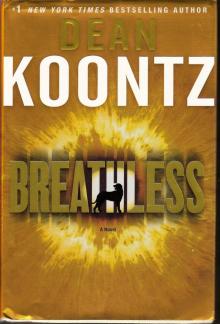 Breathless
Breathless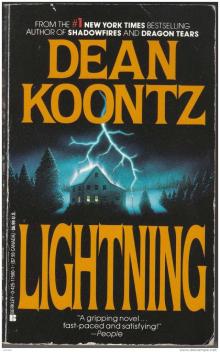 Lightning
Lightning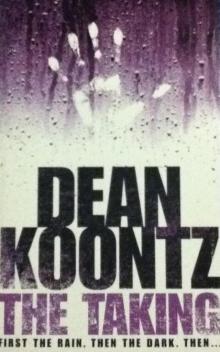 The Taking
The Taking The Door to December
The Door to December Odd Thomas
Odd Thomas Midnight
Midnight Whispers
Whispers Odd Interlude #2
Odd Interlude #2 The Mask
The Mask Watchers
Watchers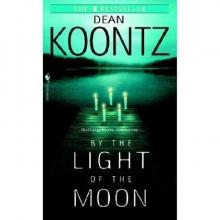 By the Light of the Moon
By the Light of the Moon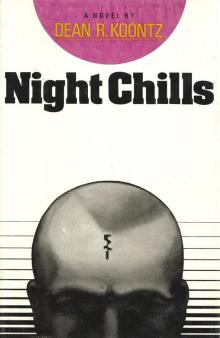 Night Chills
Night Chills Brother Odd
Brother Odd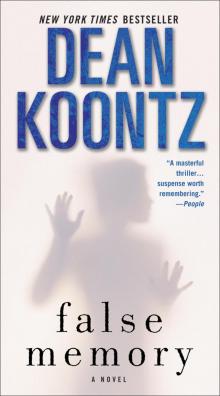 False Memory
False Memory The Darkest Evening of the Year
The Darkest Evening of the Year Life Expectancy
Life Expectancy The Good Guy
The Good Guy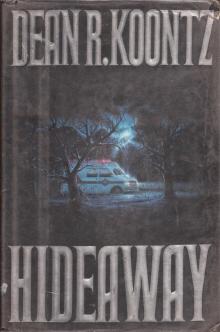 Hideaway
Hideaway Innocence
Innocence Your Heart Belongs to Me
Your Heart Belongs to Me Forever Odd
Forever Odd Intensity
Intensity Saint Odd
Saint Odd Dragon Tears
Dragon Tears The Husband
The Husband Final Hour
Final Hour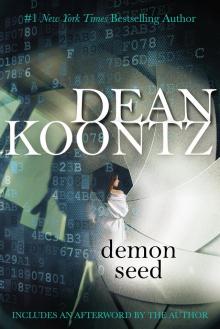 Demon Seed
Demon Seed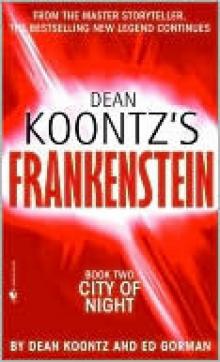 City of Night
City of Night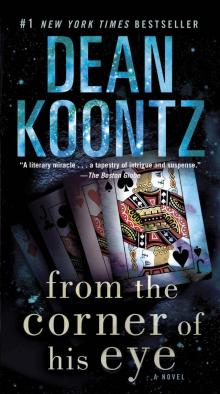 From the Corner of His Eye
From the Corner of His Eye A Big Little Life: A Memoir of a Joyful Dog
A Big Little Life: A Memoir of a Joyful Dog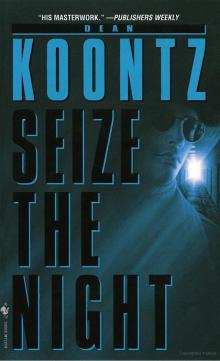 Seize the Night
Seize the Night Winter Moon
Winter Moon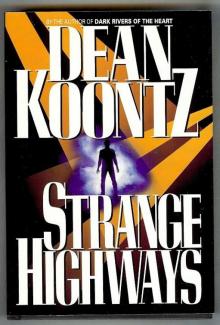 Strange Highways
Strange Highways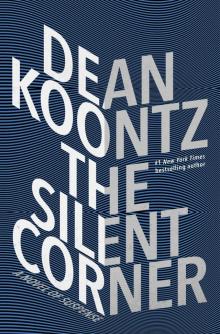 The Silent Corner
The Silent Corner Twilight Eyes
Twilight Eyes Velocity
Velocity The Bad Place
The Bad Place Cold Fire
Cold Fire The Whispering Room
The Whispering Room Ricochet Joe
Ricochet Joe The Crooked Staircase
The Crooked Staircase Tick Tock
Tick Tock The Face
The Face Sole Survivor
Sole Survivor Strangers
Strangers Deeply Odd
Deeply Odd Odd Interlude #3
Odd Interlude #3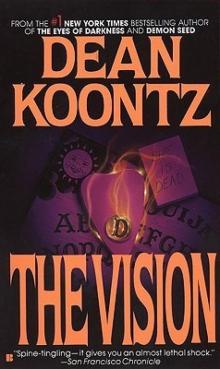 The Vision
The Vision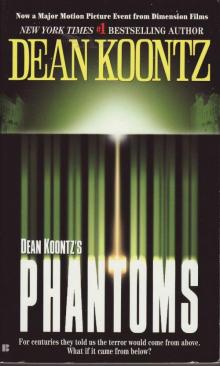 Phantoms
Phantoms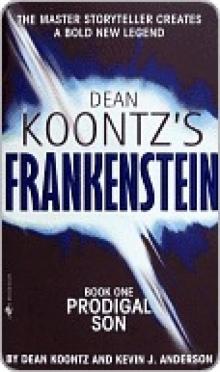 Prodigal Son
Prodigal Son Odd Hours
Odd Hours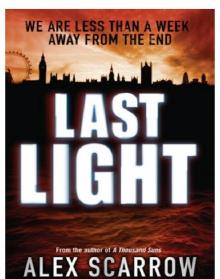 Last Light
Last Light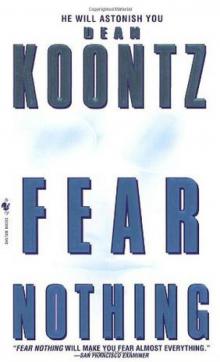 Fear Nothing
Fear Nothing Odd Interlude #1
Odd Interlude #1 One Door Away From Heaven
One Door Away From Heaven Koontz, Dean R. - Mr. Murder
Koontz, Dean R. - Mr. Murder The City
The City The Dead Town
The Dead Town The Voice of the Night
The Voice of the Night Dark Rivers of the Heart
Dark Rivers of the Heart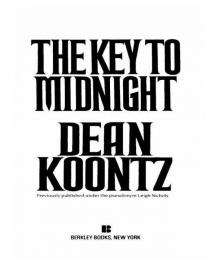 The Key to Midnight
The Key to Midnight Lost Souls
Lost Souls Odd Thomas: You Are Destined To Be Together Forever
Odd Thomas: You Are Destined To Be Together Forever Odd Apocalypse
Odd Apocalypse Icebound
Icebound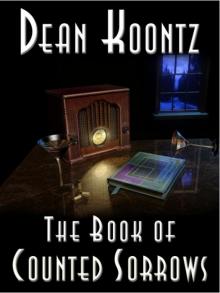 The Book of Counted Sorrows
The Book of Counted Sorrows The Neighbor
The Neighbor Ashley Bell
Ashley Bell Santa's Twin
Santa's Twin Dead and Alive
Dead and Alive The Eyes of Darkness
The Eyes of Darkness The Odd Thomas Series 4-Book Bundle
The Odd Thomas Series 4-Book Bundle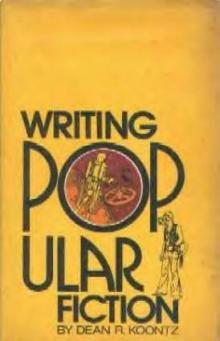 Writing Popular Fiction
Writing Popular Fiction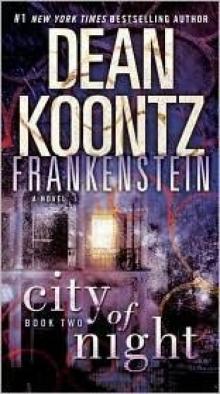 City of Night f-2
City of Night f-2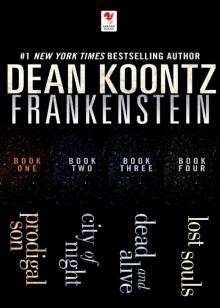 Dean Koontz's Frankenstein 4-Book Bundle
Dean Koontz's Frankenstein 4-Book Bundle What the Night Knows: A Novel
What the Night Knows: A Novel Demon Child
Demon Child Starblood
Starblood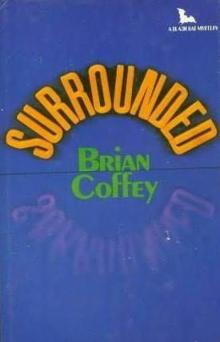 Surrounded mt-2
Surrounded mt-2 Odd Interlude #3 (An Odd Thomas Story)
Odd Interlude #3 (An Odd Thomas Story) Odd Interlude
Odd Interlude The Odd Thomas Series 7-Book Bundle
The Odd Thomas Series 7-Book Bundle The City: A Novel
The City: A Novel Deeply Odd ot-7
Deeply Odd ot-7 Odd Interlude #1 (An Odd Thomas Story)
Odd Interlude #1 (An Odd Thomas Story)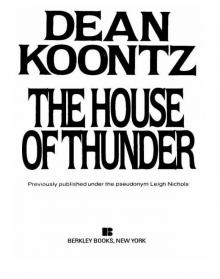 The House of Thunder
The House of Thunder Odd Interlude ot-5
Odd Interlude ot-5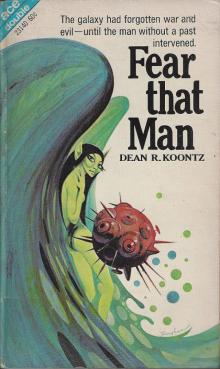 Fear That Man
Fear That Man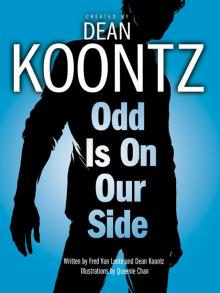 Odd Is on Our Side
Odd Is on Our Side Relentless
Relentless A Big Little Life
A Big Little Life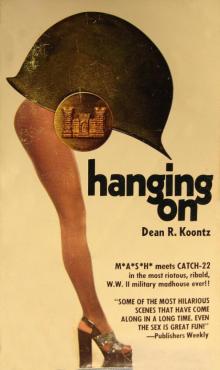 Hanging On
Hanging On The Forbidden Door
The Forbidden Door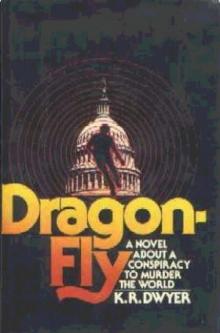 Dragonfly
Dragonfly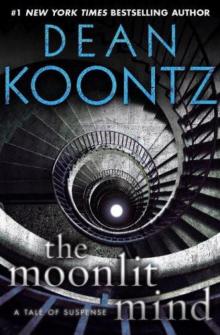 The Moonlit Mind: A Tale of Suspense
The Moonlit Mind: A Tale of Suspense Final Hour (Novella)
Final Hour (Novella) The Odd Thomas Series 4-Book Bundle: Odd Thomas, Forever Odd, Brother Odd, Odd Hours
The Odd Thomas Series 4-Book Bundle: Odd Thomas, Forever Odd, Brother Odd, Odd Hours Odd Interlude (Complete)
Odd Interlude (Complete) The Funhouse
The Funhouse 77 Shadow Street
77 Shadow Street What the Night Knows
What the Night Knows Deeply Odd: An Odd Thomas Novel
Deeply Odd: An Odd Thomas Novel The Servants of Twilight
The Servants of Twilight Star quest
Star quest Frankenstein Dead and Alive: A Novel
Frankenstein Dead and Alive: A Novel Chase
Chase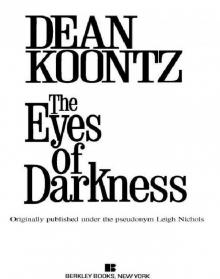 Eyes of Darkness
Eyes of Darkness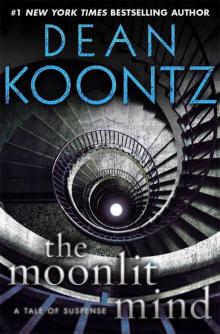 The Moonlit Mind: A Tale of Suspense (Kindle Single)
The Moonlit Mind: A Tale of Suspense (Kindle Single) Sussurri
Sussurri The Moonlit Mind (Novella)
The Moonlit Mind (Novella) Frankenstein: Lost Souls - A Novel
Frankenstein: Lost Souls - A Novel![Ricochet Joe [Kindle in Motion] (Kindle Single) Read online](http://i1.bookreadfree.com/i2/04/05/ricochet_joe_kindle_in_motion_kindle_single_preview.jpg) Ricochet Joe [Kindle in Motion] (Kindle Single)
Ricochet Joe [Kindle in Motion] (Kindle Single) Innocence: A Novel
Innocence: A Novel Beastchild
Beastchild A Darkness in My Soul
A Darkness in My Soul Oddkins: A Fable for All Ages
Oddkins: A Fable for All Ages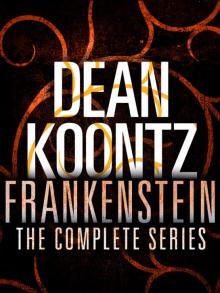 The Frankenstein Series 5-Book Bundle
The Frankenstein Series 5-Book Bundle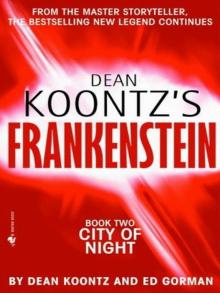 Frankenstein - City of Night
Frankenstein - City of Night Shadowfires
Shadowfires Last Light (Novella)
Last Light (Novella) Frankenstein - Prodigal Son
Frankenstein - Prodigal Son Ticktock
Ticktock Dance with the Devil
Dance with the Devil You Are Destined to Be Together Forever (Short Story)
You Are Destined to Be Together Forever (Short Story)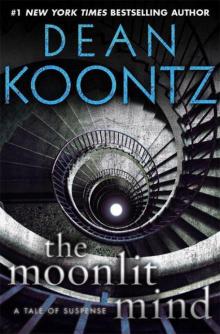 The Moonlit Mind (Novella): A Tale of Suspense
The Moonlit Mind (Novella): A Tale of Suspense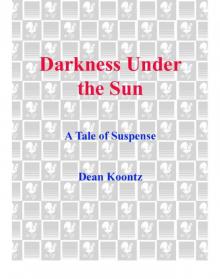 Darkness Under the Sun
Darkness Under the Sun Dark Of The Woods
Dark Of The Woods Dean Koontz's Frankenstein
Dean Koontz's Frankenstein Frankenstein
Frankenstein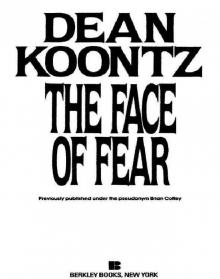 The Face of Fear
The Face of Fear Children of the Storm
Children of the Storm Mr. Murder
Mr. Murder